一开始,它是一种神秘的、类似肺炎的疾病。首批病例出现在中国商业重镇、拥有1100万人口的湖北省武汉市。最早发现病毒的地点是当地一家海鲜市场。感染者的症状表现为发烧、呼吸急促和身体疼痛。当地官员早前称,没有明确的证据表明这种病毒能在人际之间传播。
但事实并非如此。
这样的传播确实发生了,而且速度惊人。在新型冠状病毒获得正式命名的五天后,泰国确诊了中国大陆以外的首个病例。短短几周,几乎所有的亚洲国家都出现了感染者。
根据约翰·霍普金斯大学的数据,新型冠状病毒肺炎(COVID-19)已经抵达一个令人惊悚的全新里程碑——全球确诊患者达10万人之众。
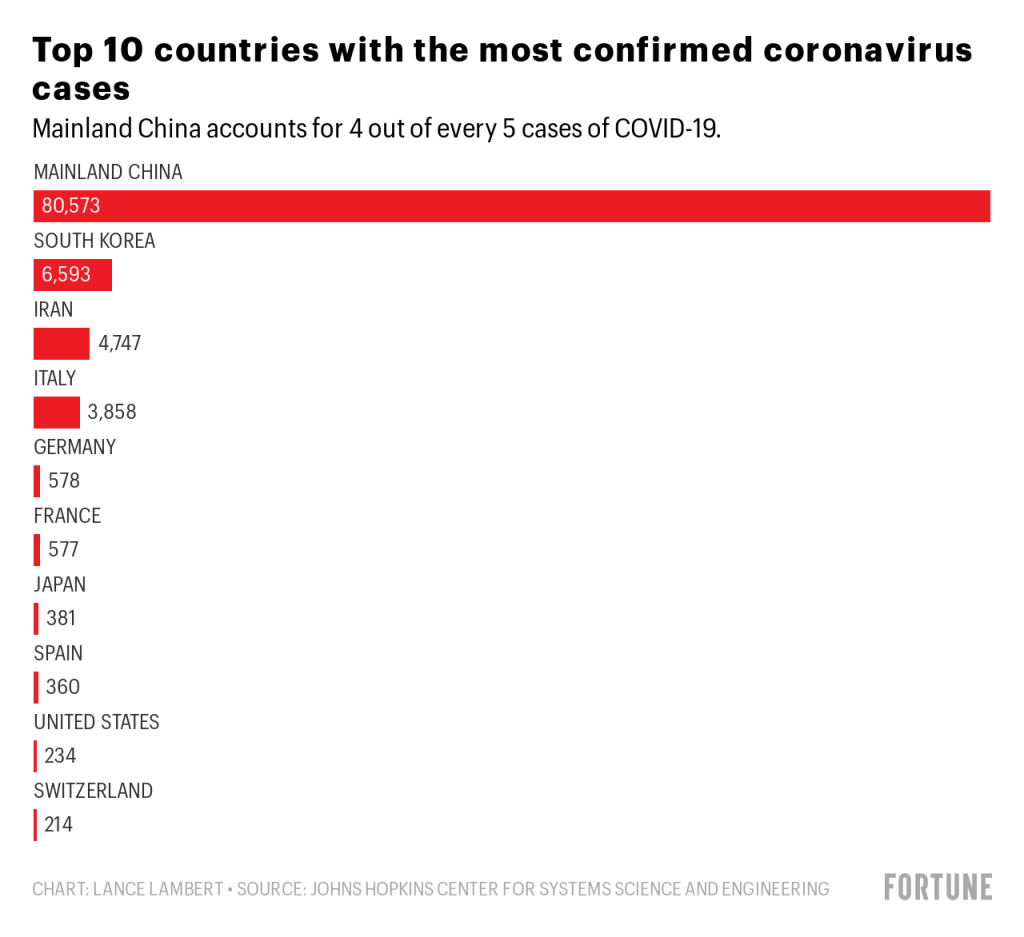
湖北省仍然是新冠疫情最严重的地区,但此次疫情在全球的持续蔓延,新的“重灾区”出现——首先是亚洲一些最大的经济体,然后在欧洲和中东部分地区集中爆发。在汹涌疫情的冲击下,人为设定的边界显得脆弱不堪,世界各国紧密而广泛的联系在此次疫情中彰显无遗。病毒所到之处,给人类留下了一系列亟待汲取的惨痛教训。
在新冠肺炎患者数量超过10万之际,让我们来回顾一下它在全球的传播路径。
日本和“钻石公主号”邮轮
1月16日,日本确诊了首例新冠病毒感染病例,患者是一位有武汉旅行史的中国男子。在接下来的一周,日本又确诊两起病例,两名患者都是来自武汉的中国公民。但很快就出现了社区传播迹象——1月28日确诊的一位男性患者从未去过中国。
尽管有证明表明社区传播已经开始,而且每年访日的中国游客数不胜数,但日本政府却迟迟没有制定一套应对病毒爆发的计划。直到2月25日,安倍内阁才勉强采取了一项旨在防止社区传播的“基本方针”,此时距离世界卫生组织将新冠疫情列为“国际关注的突发公共卫生事件”已过了近一周时间。而早在三周前,“钻石公主号”邮轮就停靠在横滨港,向日本发出了最为严峻的病毒传染挑战。
1月25日,一位“钻石公主号”乘客在香港下船;一周后,其新冠病毒检测呈阳性。彼时,这艘邮轮已经返回横滨港,但拟定在2月4日再次启航。日本政府紧急叫停这项航行计划,以便卫生防疫人员上船对乘客进行病毒筛查;他们发现了10个病例。相关部门随即对“钻石公主号”采取隔离措施,3700名乘客和船员全部不得下船。
2020年2月20日,日本横滨港。乘客们站在“钻石公主号”邮轮的甲板上。因出现新冠疫情,这艘邮轮被强制隔离在大海上。
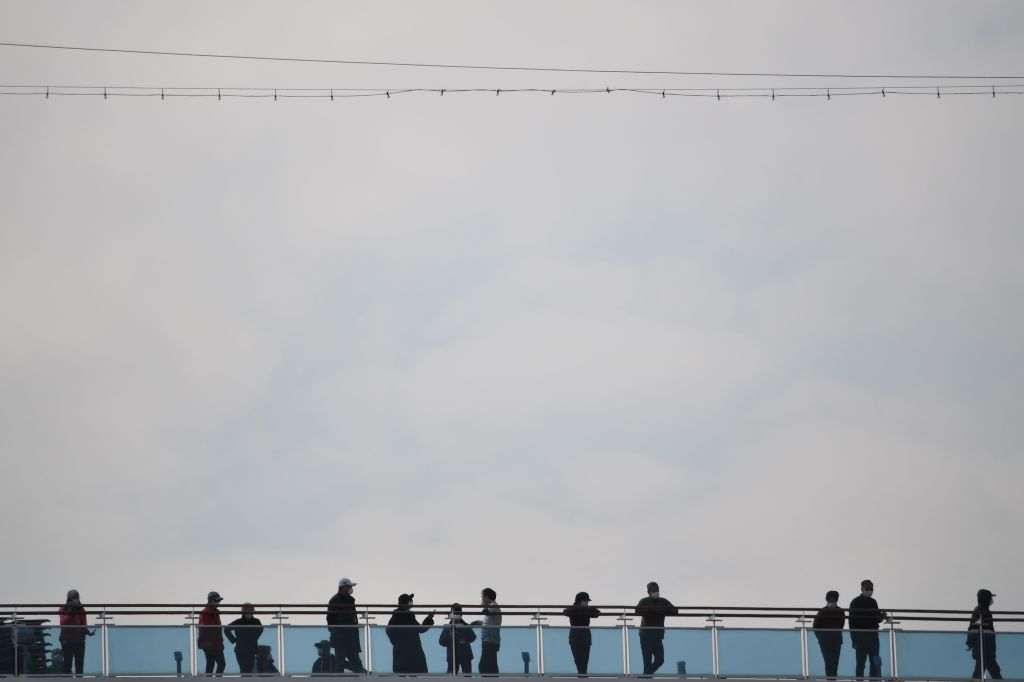
在长达一个月的隔离期,船上的感染人数激增到706人,日本政府也因思虑欠周的应对方式而饱受批评。邮轮上采取的防控措施,未能有效地将病毒感染者与其他乘客分离开来,最终导致整个隔离计划流于形式。
大多数从船上遣返的外国旅客回到本国后,还必须再接受14天的隔离检疫。但东京方面则允许那些在船上至少度过14天、病毒检测呈阳性的日本居民下船,自行回家。
一些下船的乘客后来检测出阳性病毒,而他们已经在日本各地奔波了数百公里,很有可能在沿途感染了其他人。据世界卫生组织,日本到3月10日有514例确诊病例。与新加坡这种城邦国家不同,日本病例的传播途径几乎无从寻觅。
新加坡
1月23日,新加坡报告了首例新冠肺炎病例,患者是一名从武汉抵达该国的中国妇女。据世界卫生组织,到3月10日,该国累计确诊病例已上升到160例。新加坡卫生部表示,截至9日已有93例患者治愈出院,目前还没有死亡病例。这份成绩单让新加坡成为遏制疫情的一大成功典范。然而,这个城邦国家的经验并不容易复制。
新加坡应对疫情的关键一环是,政府对其治下的600万居民实施铁腕控制。凭借执政党的强势地位,新加坡当局能够在几乎没有公众舆论阻力的情况下,采取一系列果敢行动。已有2000多人被官方隔离。不仅如此,政府还严密监视他们的一举一动,并对违规者处以严惩。一对夫妇因为谎报旅行记录而被罚款,一名外籍工人因为违反隔离令而被驱逐出境。
在一定程度上,新加坡的抗疫成就得益于2003年对抗非典(SARS)的经验,当时有238例感染者,33人死亡。这场悲剧促使政府为各大医院设置隔离设施,还建立了一家专门应对传染病的疾控中心。
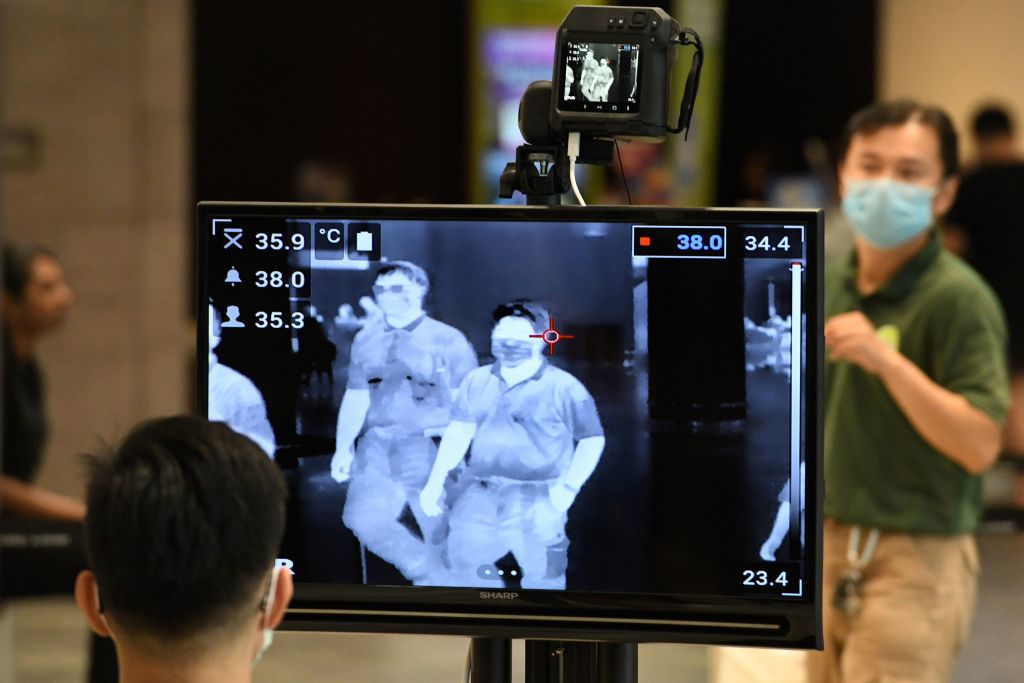
尽管反应迅速,准备充分,新加坡仍然成为一起“超级传播者”事件的原爆点。1月下旬,英国气体分析仪器公司仕富梅(Servomex)在新加坡君悦酒店召开了一场商务会议。就是在这场会议上,一位与会者不慎中招,并在经由法国返回英国的途中,不知不觉地把病毒传染给了另外11人。其中5人在法国确诊,1人在返回西班牙马略卡岛后病毒检测呈阳性。
随着“超级传播者”谣言不胫而走,各大媒体竞相确认这位将病毒传播到全球各地,并带回英国的人究竟是何方神圣。谜底最终揭晓,这个神秘男子居住在英格兰南部的霍夫市,并在那里留下了5例继发性感染病例。此后,当地一位医生被确诊,另外30名医生已经自我隔离,以防万一。
该男子随后发表声明,要求媒体尊重他的隐私。然而,在各国政府竭力遏制疫情蔓延的当下,这项个人权利正受到越来越多的质疑。新加坡之所以能有效阻止病毒传播,在很大程度上是因为政府能够及时追踪感染病例,并精确识别传染点。不止于此,政府还公开了大量数据,包括确诊病例的家庭和供职单位地址。
韩国
就在新加坡采用大规模监控手段之际,韩国开始通过大规模病毒检测来对抗新冠疫情。
1月20日,韩国报告了第一起新冠确诊病例,但在此后的一段时间,该国的疫情基本上得到控制——直到2月18日,病毒突然在位于韩国南部的大邱市集中爆发。据调查,此次疫情与韩国新天地教会旗下一个支派有关。

一位61岁的妇女被确定为新天地教徒群的“零号病人”;她经常参加教会礼拜活动,据说她特别喜欢跟教友进行密切的身体接触。截至3月1日,韩国卫生官员已追踪到至少3736例跟该女子有关的确诊病例。截至3月6日,韩国累计报告6500例确诊病例,至少有40人死亡。
这名女子最近没有中国旅行史,但她的病例揭示出中韩两国民众的官方和隐秘联系已经达到何等紧密的程度。根据中国2010年的人口普查数据,约有100万中国公民居住在韩国,居住在中国的韩国人至少有12万。尽管新天地教会被中国官方禁止,但这个神秘的极端基督教教派在武汉拥有一个信徒多达数百名的分支。最近,至少有一些居住在大邱市的新天地教徒去过武汉。
应对这场危机时,韩国政府没有像中国那样采取强制封锁措施,而是联合生物科技公司开展了一场规模空前的检测行动。迄今已有数十万人接受病毒检测,其中一些检测是通过“得来速式”诊所进行的。

此外,韩国政府还对新天地教会本身采取了突袭搜查行动。在记者会上,新天地教会会长李万熙首次公开发声,并向民众跪地道歉,但鉴于该教会向防疫部门隐瞒信息,致使疫情爆发式增长,韩国检方据称仍然会以过失杀人等罪名向其提出刑事控告。
意大利
在意大利,新冠疫情充分暴露了该国北部的伦巴第大区与中国浙江省的深层联系,尽管两地相隔9000公里。
意大利政府在1月下旬报告称,两名在罗马观光的中国游客成为该国头两例新冠确诊病例。但当局现在认为,这两名中国公民并没有感染其他人。在接下来的几周,新增感染人数一直在低位运行。意大利总理朱塞佩·孔特当时表示,这是因为意大利采取了欧洲“最严格”的预防措施。
但好景不长,意大利政府在2月21日报告称,在伦巴第大区所辖的科多尼奥镇,一名38岁男子感染了新冠病毒,但并不清楚这位名叫马蒂亚的男子是如何感染的,因为他最近没有去过中国。不过,由于马蒂亚引发该地区病例爆炸式增长,他被确定为“零号病人”。在马蒂亚确诊后一周内,意大利北部地区共出现了888例确诊病例。当局为此封锁了该国北部多个城镇,全面禁止体育赛事等大型集会,并暂时关闭了全国所有的中小学和大学。
这波疫情也标志着一些首次报告的确诊病例正在从境外输入中国。浙江省3月2日报告称,8位从意大利伦巴第大区回国的中国公民被确诊为新冠肺炎患者。目前有30多万中国人居住在意大利,其中约90%来自浙江省。意大利的服装业吸引了大批中国工人。
这些境外输入性病例促使中国政府开始对外国旅客采取隔离措施,并敦促海外华人不要回国,以免引发新的疫情。
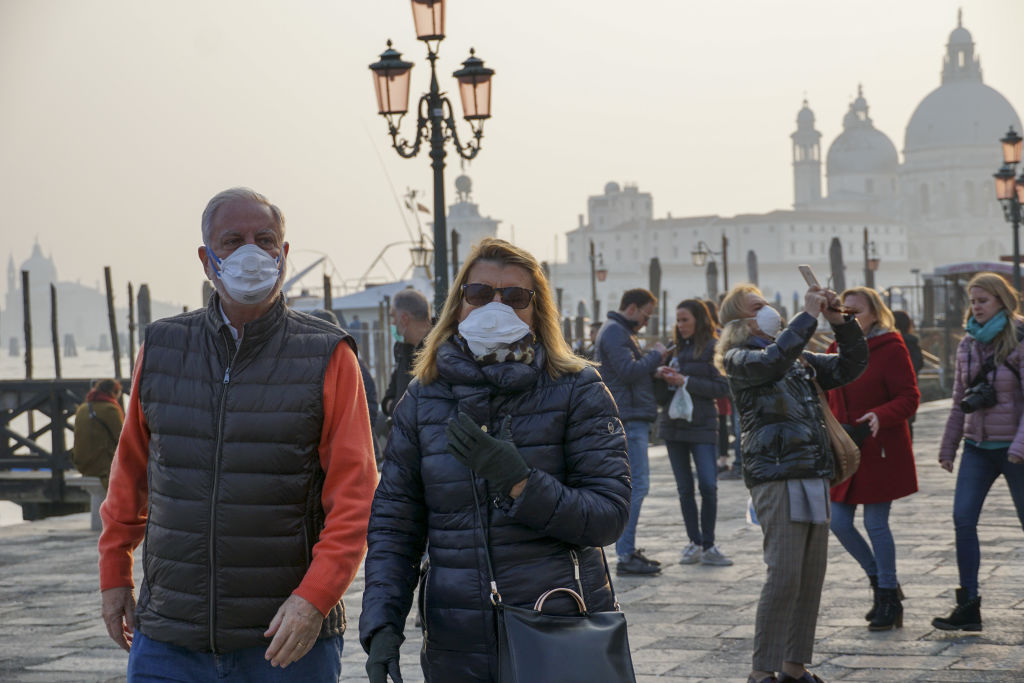
意大利是世界上新冠病毒死亡率最高的国家之一:3858名感染者中有148人死亡,死亡率接近4%。它还是世界上老龄人口比例第二高的国家,专家们怀疑,该国的老年人尤其容易受到致命感染。
伊朗
就在意大利在疫情爆发初期吹嘘该国确诊病例保持低位的同时,伊朗官员也过早地流露出乐观情绪。仅仅两周前,伊朗官员还在为该国的卫生体系唱赞歌,并信誓旦旦地预测称,该国不会受到新冠疫情的影响。此后,伊朗迅速跃升为新冠病毒最大的温床之一,截至3月6日,累计报告近3000确诊病例,92人死亡。
2月19日,伊朗当局证实,卫生部门在库姆市发现该国头两起确诊病例,当天晚些时候再次发布通告称,这两位患者都已死亡。卫生部长表示,新冠病毒是一位经常往返于库姆市和中国的商人传到伊朗的,这位商人是两名死者之一。
自那时起,病毒迅速蔓延到至少另外三座城市,其中包括首都德黑兰。而就在此前,伊朗官员还表态称,政府不会对城镇采取隔离措施,也无意关闭宗教圣地,并且鼓励公民前往投票站参加议会选举。
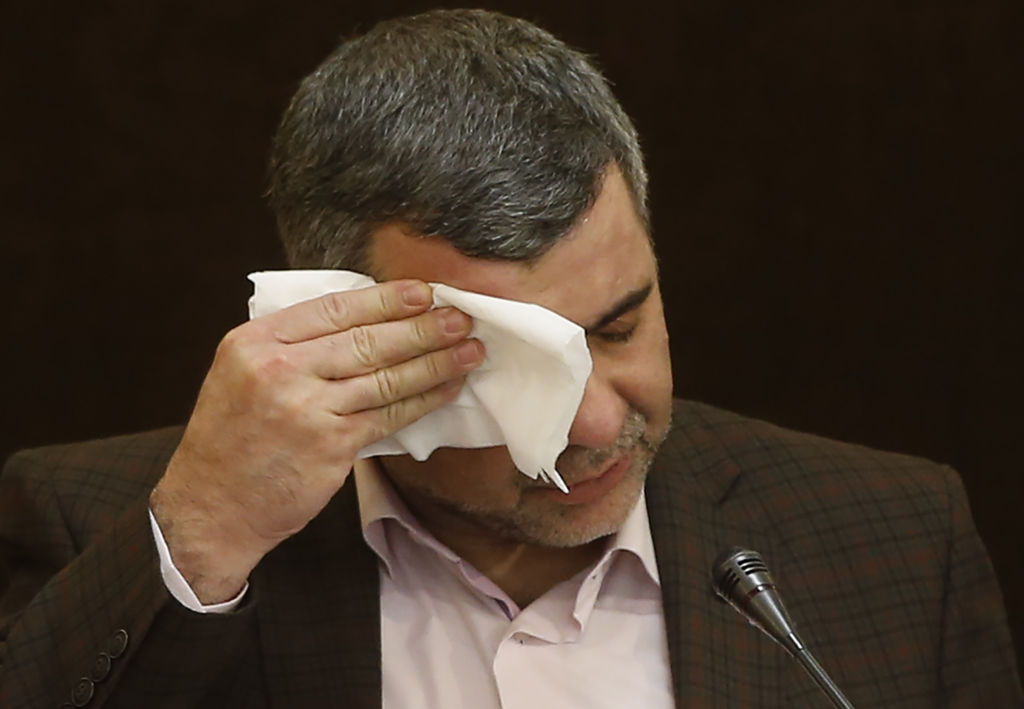
卫生部副部长哈利其表示,截至2月24日,确诊人数已增至61例。在他宣布这些数字的新闻发布会上,哈利其本人成了媒体关注的焦点。就在他淡化新冠疫情严重程度的时候,哈利其不时地用手遮挡咳嗽,还摘掉眼镜,频频擦拭额头的汗水。发布会期间,甚至有一位工作人员走上讲台,递给他一盒新纸巾。
第二天,哈利其的新冠病毒检测呈阳性。
大约8%的伊朗国会议员感染了新冠病毒,伊朗最高领袖的一名高级顾问于3月2日不治身亡。全国现有超过3500例确诊病例,至少107人死亡。
一些中小学校和大学现已关闭,但主要的宗教场所仍然开放,一名医生称此举无异于“犯罪”。(为了控制疫情蔓延,伊朗本周暂停了所有省会城市的周五祈祷活动。)一些医务人员透露称,当局警告他们不要乱说话。一名议员说官方数字是个“笑话”,并表示真实的感染和死亡人数要高得多。
伊朗卫生部于上周四表示,政府已经批准了多项旨在控制疫情的法案,还说世卫组织对该部门的防疫计划表示认可。这些措施包括设立检查站以限制各大城市之间的旅行,并鼓励公众尽可能少地使用纸币。
一些观察家指出,德黑兰当局起初不愿限制中国公民入境,是因为政府不愿损害伊朗与其最大贸易伙伴的关系;美国的制裁也可能导致医疗设备短缺。现如今,伊朗已经成为新冠疫情在中东地区传播的原爆点,该地区的大多数新增病例都跟伊朗有关。
这个病毒很“民主”
迄今为止,新冠病毒至少已蔓延到84个国家,其传播速度之快令人震惊。纽约州州长安德鲁·科莫在上周三表示:“防疫之难简直就像试图阻止空气流动。”
各国政府抗疫的一大举措是,严格限制哪些人可以穿越哪些边界。事后来看,这些举措确实颇为明智,但新冠病毒一再突破城市封锁线和各国的飞行禁令。
在他确诊后发布的一段自拍视频中,伊朗卫生部副部长哈利其调侃说:这个病毒很“民主”。
“从不区分贫富贵贱。”他说。
新冠病毒也不区分地理位置。从这个意义上说,它无视国界的传播性已经让当下的政治气候陷入极其难堪的境地。在这样一个孤立主义甚嚣尘上、民族主义情绪日益加剧的时代,高耸的围墙正拔地而起,各种国际集团竞相走向瓦解,但新冠疫情确实是一个全球性问题,我们仍在迫切期待着一个全球性解决方案。(财富中文网)
译者:任文科
一开始,它是一种神秘的、类似肺炎的疾病。首批病例出现在中国商业重镇、拥有1100万人口的湖北省武汉市。最早发现病毒的地点是当地一家海鲜市场。感染者的症状表现为发烧、呼吸急促和身体疼痛。当地官员早前称,没有明确的证据表明这种病毒能在人际之间传播。
但事实并非如此。
这样的传播确实发生了,而且速度惊人。在新型冠状病毒获得正式命名的五天后,泰国确诊了中国大陆以外的首个病例。短短几周,几乎所有的亚洲国家都出现了感染者。
根据约翰·霍普金斯大学的数据,新型冠状病毒肺炎(COVID-19)已经抵达一个令人惊悚的全新里程碑——全球确诊患者达10万人之众。
湖北省仍然是新冠疫情最严重的地区,但此次疫情在全球的持续蔓延,新的“重灾区”出现——首先是亚洲一些最大的经济体,然后在欧洲和中东部分地区集中爆发。在汹涌疫情的冲击下,人为设定的边界显得脆弱不堪,世界各国紧密而广泛的联系在此次疫情中彰显无遗。病毒所到之处,给人类留下了一系列亟待汲取的惨痛教训。
在新冠肺炎患者数量超过10万之际,让我们来回顾一下它在全球的传播路径。
日本和“钻石公主号”邮轮
1月16日,日本确诊了首例新冠病毒感染病例,患者是一位有武汉旅行史的中国男子。在接下来的一周,日本又确诊两起病例,两名患者都是来自武汉的中国公民。但很快就出现了社区传播迹象——1月28日确诊的一位男性患者从未去过中国。
尽管有证明表明社区传播已经开始,而且每年访日的中国游客数不胜数,但日本政府却迟迟没有制定一套应对病毒爆发的计划。直到2月25日,安倍内阁才勉强采取了一项旨在防止社区传播的“基本方针”,此时距离世界卫生组织将新冠疫情列为“国际关注的突发公共卫生事件”已过了近一周时间。而早在三周前,“钻石公主号”邮轮就停靠在横滨港,向日本发出了最为严峻的病毒传染挑战。
1月25日,一位“钻石公主号”乘客在香港下船;一周后,其新冠病毒检测呈阳性。彼时,这艘邮轮已经返回横滨港,但拟定在2月4日再次启航。日本政府紧急叫停这项航行计划,以便卫生防疫人员上船对乘客进行病毒筛查;他们发现了10个病例。相关部门随即对“钻石公主号”采取隔离措施,3700名乘客和船员全部不得下船。
在长达一个月的隔离期,船上的感染人数激增到706人,日本政府也因思虑欠周的应对方式而饱受批评。邮轮上采取的防控措施,未能有效地将病毒感染者与其他乘客分离开来,最终导致整个隔离计划流于形式。
大多数从船上遣返的外国旅客回到本国后,还必须再接受14天的隔离检疫。但东京方面则允许那些在船上至少度过14天、病毒检测呈阳性的日本居民下船,自行回家。
一些下船的乘客后来检测出阳性病毒,而他们已经在日本各地奔波了数百公里,很有可能在沿途感染了其他人。据世界卫生组织,日本到3月10日有514例确诊病例。与新加坡这种城邦国家不同,日本病例的传播途径几乎无从寻觅。
新加坡
1月23日,新加坡报告了首例新冠肺炎病例,患者是一名从武汉抵达该国的中国妇女。据世界卫生组织,到3月10日,该国累计确诊病例已上升到160例。新加坡卫生部表示,截至9日已有93例患者治愈出院,目前还没有死亡病例。这份成绩单让新加坡成为遏制疫情的一大成功典范。然而,这个城邦国家的经验并不容易复制。
新加坡应对疫情的关键一环是,政府对其治下的600万居民实施铁腕控制。凭借执政党的强势地位,新加坡当局能够在几乎没有公众舆论阻力的情况下,采取一系列果敢行动。已有2000多人被官方隔离。不仅如此,政府还严密监视他们的一举一动,并对违规者处以严惩。一对夫妇因为谎报旅行记录而被罚款,一名外籍工人因为违反隔离令而被驱逐出境。
在一定程度上,新加坡的抗疫成就得益于2003年对抗非典(SARS)的经验,当时有238例感染者,33人死亡。这场悲剧促使政府为各大医院设置隔离设施,还建立了一家专门应对传染病的疾控中心。
尽管反应迅速,准备充分,新加坡仍然成为一起“超级传播者”事件的原爆点。1月下旬,英国气体分析仪器公司仕富梅(Servomex)在新加坡君悦酒店召开了一场商务会议。就是在这场会议上,一位与会者不慎中招,并在经由法国返回英国的途中,不知不觉地把病毒传染给了另外11人。其中5人在法国确诊,1人在返回西班牙马略卡岛后病毒检测呈阳性。
随着“超级传播者”谣言不胫而走,各大媒体竞相确认这位将病毒传播到全球各地,并带回英国的人究竟是何方神圣。谜底最终揭晓,这个神秘男子居住在英格兰南部的霍夫市,并在那里留下了5例继发性感染病例。此后,当地一位医生被确诊,另外30名医生已经自我隔离,以防万一。
该男子随后发表声明,要求媒体尊重他的隐私。然而,在各国政府竭力遏制疫情蔓延的当下,这项个人权利正受到越来越多的质疑。新加坡之所以能有效阻止病毒传播,在很大程度上是因为政府能够及时追踪感染病例,并精确识别传染点。不止于此,政府还公开了大量数据,包括确诊病例的家庭和供职单位地址。
韩国
就在新加坡采用大规模监控手段之际,韩国开始通过大规模病毒检测来对抗新冠疫情。
1月20日,韩国报告了第一起新冠确诊病例,但在此后的一段时间,该国的疫情基本上得到控制——直到2月18日,病毒突然在位于韩国南部的大邱市集中爆发。据调查,此次疫情与韩国新天地教会旗下一个支派有关。
一位61岁的妇女被确定为新天地教徒群的“零号病人”;她经常参加教会礼拜活动,据说她特别喜欢跟教友进行密切的身体接触。截至3月1日,韩国卫生官员已追踪到至少3736例跟该女子有关的确诊病例。截至3月6日,韩国累计报告6500例确诊病例,至少有40人死亡。
这名女子最近没有中国旅行史,但她的病例揭示出中韩两国民众的官方和隐秘联系已经达到何等紧密的程度。根据中国2010年的人口普查数据,约有100万中国公民居住在韩国,居住在中国的韩国人至少有12万。尽管新天地教会被中国官方禁止,但这个神秘的极端基督教教派在武汉拥有一个信徒多达数百名的分支。最近,至少有一些居住在大邱市的新天地教徒去过武汉。
应对这场危机时,韩国政府没有像中国那样采取强制封锁措施,而是联合生物科技公司开展了一场规模空前的检测行动。迄今已有数十万人接受病毒检测,其中一些检测是通过“得来速式”诊所进行的。
此外,韩国政府还对新天地教会本身采取了突袭搜查行动。在记者会上,新天地教会会长李万熙首次公开发声,并向民众跪地道歉,但鉴于该教会向防疫部门隐瞒信息,致使疫情爆发式增长,韩国检方据称仍然会以过失杀人等罪名向其提出刑事控告。
意大利
在意大利,新冠疫情充分暴露了该国北部的伦巴第大区与中国浙江省的深层联系,尽管两地相隔9000公里。
意大利政府在1月下旬报告称,两名在罗马观光的中国游客成为该国头两例新冠确诊病例。但当局现在认为,这两名中国公民并没有感染其他人。在接下来的几周,新增感染人数一直在低位运行。意大利总理朱塞佩·孔特当时表示,这是因为意大利采取了欧洲“最严格”的预防措施。
但好景不长,意大利政府在2月21日报告称,在伦巴第大区所辖的科多尼奥镇,一名38岁男子感染了新冠病毒,但并不清楚这位名叫马蒂亚的男子是如何感染的,因为他最近没有去过中国。不过,由于马蒂亚引发该地区病例爆炸式增长,他被确定为“零号病人”。在马蒂亚确诊后一周内,意大利北部地区共出现了888例确诊病例。当局为此封锁了该国北部多个城镇,全面禁止体育赛事等大型集会,并暂时关闭了全国所有的中小学和大学。
这波疫情也标志着一些首次报告的确诊病例正在从境外输入中国。浙江省3月2日报告称,8位从意大利伦巴第大区回国的中国公民被确诊为新冠肺炎患者。目前有30多万中国人居住在意大利,其中约90%来自浙江省。意大利的服装业吸引了大批中国工人。
这些境外输入性病例促使中国政府开始对外国旅客采取隔离措施,并敦促海外华人不要回国,以免引发新的疫情。
意大利是世界上新冠病毒死亡率最高的国家之一:3858名感染者中有148人死亡,死亡率接近4%。它还是世界上老龄人口比例第二高的国家,专家们怀疑,该国的老年人尤其容易受到致命感染。
伊朗
就在意大利在疫情爆发初期吹嘘该国确诊病例保持低位的同时,伊朗官员也过早地流露出乐观情绪。仅仅两周前,伊朗官员还在为该国的卫生体系唱赞歌,并信誓旦旦地预测称,该国不会受到新冠疫情的影响。此后,伊朗迅速跃升为新冠病毒最大的温床之一,截至3月6日,累计报告近3000确诊病例,92人死亡。
2月19日,伊朗当局证实,卫生部门在库姆市发现该国头两起确诊病例,当天晚些时候再次发布通告称,这两位患者都已死亡。卫生部长表示,新冠病毒是一位经常往返于库姆市和中国的商人传到伊朗的,这位商人是两名死者之一。
自那时起,病毒迅速蔓延到至少另外三座城市,其中包括首都德黑兰。而就在此前,伊朗官员还表态称,政府不会对城镇采取隔离措施,也无意关闭宗教圣地,并且鼓励公民前往投票站参加议会选举。
卫生部副部长哈利其表示,截至2月24日,确诊人数已增至61例。在他宣布这些数字的新闻发布会上,哈利其本人成了媒体关注的焦点。就在他淡化新冠疫情严重程度的时候,哈利其不时地用手遮挡咳嗽,还摘掉眼镜,频频擦拭额头的汗水。发布会期间,甚至有一位工作人员走上讲台,递给他一盒新纸巾。
第二天,哈利其的新冠病毒检测呈阳性。
大约8%的伊朗国会议员感染了新冠病毒,伊朗最高领袖的一名高级顾问于3月2日不治身亡。全国现有超过3500例确诊病例,至少107人死亡。
一些中小学校和大学现已关闭,但主要的宗教场所仍然开放,一名医生称此举无异于“犯罪”。(为了控制疫情蔓延,伊朗本周暂停了所有省会城市的周五祈祷活动。)一些医务人员透露称,当局警告他们不要乱说话。一名议员说官方数字是个“笑话”,并表示真实的感染和死亡人数要高得多。
伊朗卫生部于上周四表示,政府已经批准了多项旨在控制疫情的法案,还说世卫组织对该部门的防疫计划表示认可。这些措施包括设立检查站以限制各大城市之间的旅行,并鼓励公众尽可能少地使用纸币。
一些观察家指出,德黑兰当局起初不愿限制中国公民入境,是因为政府不愿损害伊朗与其最大贸易伙伴的关系;美国的制裁也可能导致医疗设备短缺。现如今,伊朗已经成为新冠疫情在中东地区传播的原爆点,该地区的大多数新增病例都跟伊朗有关。
这个病毒很“民主”
迄今为止,新冠病毒至少已蔓延到84个国家,其传播速度之快令人震惊。纽约州州长安德鲁·科莫在上周三表示:“防疫之难简直就像试
阻止空气流动。”
各国政府抗疫的一大举措是,严格限制哪些人可以穿越哪些边界。事后来看,这些举措确实颇为明智,但新冠病毒一再突破城市封锁线和各国的飞行禁令。
在他确诊后发布的一段自拍视频中,伊朗卫生部副部长哈利其调侃说:这个病毒很“民主”。
“从不区分贫富贵贱。”他说。
新冠病毒也不区分地理位置。从这个意义上说,它无视国界的传播性已经让当下的政治气候陷入极其难堪的境地。在这样一个孤立主义甚嚣尘上、民族主义情绪日益加剧的时代,高耸的围墙正拔地而起,各种国际集团竞相走向瓦解,但新冠疫情确实是一个全球性问题,我们仍在迫切期待着一个全球性解决方案。(财富中文网)
译者:任文科
It started as a mysterious, pneumonia-like illness. Cases of it appeared before Christmas in the Chinese commercial center of Wuhan, population 11 million, traced to a wet market there. It presented in infected patients as a fever, shortness of breath, and body aches. Wuhan officials said early on there was no clear evidence it could be transmitted from human to human.
They were wrong.
Such transmission did occur—at an alarming rate. Five days after it got its coronavirus name, Thailand confirmed the first case outside of mainland China. Within weeks, infections dotted nearly every country in Asia.
Now the coronavirus, which causes the disease COVID-19, has reached the new, ominous milestone of 100,000 global infections, according to Johns Hopkins data.
Wuhan's Hubei Province remains the most affected with 67,600 cases and over 2,900 deaths in total. But the outbreak's ongoing march across the globe has revealed new hotbeds of contagion—first in some of Asia's biggest economies and then in concentrated pockets in Europe and the Middle East. It has exposed borders as flimsy human constructs, underscored the world's vast connectedness, and left a trail of lessons to be learned.
As the coronavirus counter ticks to 100,001, here's a look back at some of the ways it's spread.
Japan and the Diamond Princess
Japan confirmed its first case of coronavirus on Jan. 16. The patient was a man from China who had traveled to Japan from Wuhan. Over the next week, Japan confirmed two more cases, both Chinese nationals who had travelled from Wuhan. But soon there were signs of community transmission, as a case confirmed on Jan. 28 was recorded in a man who had never visited China.
Despite the evidence of community transmission and the high number of Chinese tourists that visit Japan each year, the Japanese government was slow to develop a response plan to the viral outbreak. Tokyo only adopted a “basic policy” to prevent community spread on Feb. 25—nearly a month after the World Health Organization had declared the outbreak a Public Health Emergency of International Concern and three weeks after the Diamond Princess cruise ship docked in the city of Yokohama, issuing Japan its biggest coronavirus challenge.
A former passenger of the Diamond Princess, who had disembarked in Hong Kong on Jan. 25, tested positive for COVID-19 a week later. By this time, the cruise ship was back in Yokohama but due to depart on Feb. 4. That sailing was cancelled so Japanese authorities could screen passengers for the virus; they found ten cases. The cruise liner was put under quarantine, with all 3,700 passengers and crew locked on board.
During the month-long quarantine, the number of infected people on the ship swelled to 706 as Japanese authorities faced criticism for bungling the situation. There were no effective quarantine measures on board the ship to separate infected passengers from the others, rendering the quarantine exercise ineffective.
Most foreign passengers repatriated from the ship were subjected to a further 14-day quarantine after arriving home. In Japan, however, Tokyo allowed Japanese citizens who had not yet tested positive for coronavirus to leave the boat and return home after the minimum 14-days on board.
A number of disembarked passengers later tested positive for coronavirus, having already travelled hundreds of kilometers across the country, risking infection to others along the way. Japan now has 360 cases of coronavirus and, unlike in city states such as Singapore, the route of transmission has become virtually impossible to track.
Singapore
Singapore reported its first case on Jan. 23—a Chinese woman who had flown from Wuhan, the center of the outbreak. Since then, cases have risen to 117; 78 have recovered with no deaths, making the city-state a prime example of how to contain the coronavirus. However, Singapore’s success is not easy to replicate.
The key to tackling the outbreak has been the government’s iron grip on power over its 6 million residents. The strong party rule has allowed authorities to act resolutely with little resistance from the public. Officials have put more than 2,000 people in quarantine, with the government placing them under close surveillance and punishing those who break protocol. A couple was fined for lying about their travel history, and an expat worker was expelled after breaking quarantine.
In a way, Singapore has benefitted from its experience with SARS, or severe acute respiratory syndrome, in 2003 when the city suffered 33 deaths from 238 cases. The tragedy prompted the government to install quarantine facilities in its hospitals and build a dedicated center for infectious diseases.
But despite its swift response and advanced preparation, Singapore still became ground zero for a coronavirus “super spreader” event in late January. An attendee at a business conference hosted by U.K. gas analytics firm Servomex at the Grand Hyatt in Singapore contracted the disease and unwittingly transmitted it to 11 others as he returned to the U.K. via France. Five of the 11 were confirmed infected in France while one traveled back to Mallorca, Spain, before testing positive.
As rumors of the “super spreader” emerged, media outlets raced to identify the individual who’d carried the virus across the globe and back to the U.K., eventually unmasking him as a man from Hove, in South England, where the five remaining secondary infections took place. One doctor from the area has since been diagnosed with the virus, and 30 other doctors have isolated themselves as a precaution.
In a statement, the Hove man asked the media to respect his privacy, an individual right that's been called into question as governments struggle to limit contagion. In Singapore, the government’s ability to track cases and identify points of transmission has been integral to interrupting the disease’s spread—but the state also makes a lot of that data publicly available, including the home and business addresses of patients.
South Korea
Whereas Singapore has deployed mass surveillance to combat the coronavirus, South Korea has turned to mass testing.
South Korea reported its first confirmed case of coronavirus on Jan. 20, but the disease remained mostly contained in the country until Feb. 18, when an outbreak tied to a branch of Shincheonji Church of Jesus, a secretive extreme Christian sect, popped up in the southern city of Daegu.
A 61-year-old woman became known as patient zero of the Shincheonji cluster; she’d attended church services regularly and was known for fostering close physical contact with fellow worshippers. As of March 1, South Korean health officials had traced at least 3,736 confirmed cases to her. In total, South Korea has reported more than 6,500 infections and at least 40 deaths as of Friday.
While the woman had not recently traveled to China, her case exposes how intertwined China and South Korea’s populations are in official and under-the-radar ways. An estimated 1 million Chinese nationals live in South Korea, and there are at least 120,000 South Koreans living in China, according to China’s 2010 census. While religion is officially banned in China, the Shincheonji Church has a branch with hundreds of followers in Wuhan, which at least some Daegu-based parishioners had visited recently.
Rather than impose lock-down style measures as China did, South Korean authorities and biotech companies mobilized an expansive testing operation in response to the crisis, testing hundreds of thousands of people, some via drive-thru style clinics.
South Korea has also cracked down on the Shincheonji church itself. Church leader Lee Man-hee bowed on the ground begging for forgiveness during a press conference on Monday, but authorities are reportedly still pursuing homicide charges against him due to the church hiding information about the outbreak.
Italy
In Italy, the coronavirus has revealed the deep ties between two regions—Lombardy in the country's north, and Zhejiang in China's south, separated by 9,000 kilometers.
In late January, Italian authorities confirmed the first two cases of coronavirus from two Chinese tourists in Rome, but authorities now believe that the two Chinese nationals did not infect anyone else. For weeks, new infections remained low and at the time the Italian Prime Minister Giuseppe Conte said it was because Italy employed the “most rigorous” prevention measures in Europe.
But on Feb. 21, Italy reported that a 38-year-old man identified as Mattia had coronavirus in Codogno, a small town in Italy’s northern Lombardy region. How Mattia became infected remains unclear as he had not recently traveled to China, but he became known as patient zero for triggering a surge in cases across the region. In the week after Italy confirmed Mattia’s case, 888 people were diagnosed with the disease across northern Italy. In response, authorities quarantined towns across northern Italy, banned large gatherings like sporting events, and temporarily closed all schools and universities nationwide.
Italy’s outbreak has also marked some of the first reported cases of coronavirus being imported back to China. Qingtian, a small county in China’s southeastern Zhejiang province, confirmed eight new cases of coronavirus on March 2 from Chinese nationals living in Italy’s Lombardy region. There are more than 300,000 Chinese nationals living in Italy, and roughly 90% of them in the Zhejiang Province; the garment industry there has attracted Chinese workers.
These imported cases prompted Chinese authorities to begin quarantining foreign travelers and urging overseas Chinese populations to stay away in fears of they might lead to new outbreaks.
At nearly 4%, Italy has one of the highest death rates of coronavirus in the world, as 148 of 3,858 infected people have died. Italy has the world’s second-oldest population, and experts suspect that the country’s elderly citizens are particularly vulnerable to fatal infections.
Iran
Just as Italy had touted its low caseload early in the outbreak, officials in Iran also spoke too soon. Just two weeks ago, officials in Iran, praising the country’s health system, predicted the country would not be affected by the coronavirus outbreak. Iran has since become one of the biggest hotbeds of the disease, logging nearly 3,000 cases and 92 deaths.
On Feb. 19, Iran confirmed its first two cases in the city of Qom—and later that day said both people had died. The health minister said the virus arrived in Iran via a merchant who frequently traveled between Qom and China and who was one of the two deaths.
The virus has since spread to at least three more cities, including Tehran, the capital, after officials said they would not put towns under quarantine or close religious pilgrimage sites; they encouraged citizens to go to the polls for parliamentary elections.
By Feb. 24, cases had jumped to 61, according to deputy health minister Iraj Harirchi. At the press conference to announce the figures, Harirchi's own condition became a focus. As he downplayed the virus’s spread, Harirchi coughed into his hand and removed his glasses to wipe sweat from his brow so often that at one point someone stepped onto the podium to hand him a new box of tissues.
The next day, Harirchi tested positive for COVID-19.
Around 8% of Iran’s members of parliament have contracted the virus, and a senior advisor to Iran’s supreme leader died of the disease on March 2. The nation now has more than 3,500 cases; at least 107 people have died.
Some schools and universities are closed, but major religious sites remain open, a move one doctor described as "criminal." (Iran has halted Friday prayers in all provincial capitals this week to control the spread of the outbreak.) Medical staff say they have been told to keep quiet about the outbreak. One lawmaker called official numbers “a joke” and said in reality the infection and death counts are much higher.
Iran's health ministry said on Thursday the government had approved several bills aiming to contain the outbreak, and said the WHO approved of the ministry's plans, which include setting up checkpoints to limit travel between major cities and encouraging the public to limit the use of paper money.
Some see Iran’s early opposition to restricting travel from China as government reluctance to jeopardize its relationship with its largest trading partner; U.S. sanctions may be contributing to a medical equipment shortage as well. Iran has become a sort of ground zero of the virus in the Middle Ease, with most of the new cases in the region linking back to Iran.
A 'democratic' virus
That the coronavirus has reached so far—to least 84 countries—so fast is alarming. "This is literally like trying to stop air," New York Governor Andrew Cuomo said Wednesday, as the state confirmed five new cases.
Governments have tried to tame the outbreak, in part, by limiting who can cross what border. And while some of those measures have proven wise in hindsight, the coronavirus has repeatedly defied city lockdowns and countries' flight restrictions.
In a selfie video posted after his COVID-19 diagnosis, Harirchi, the deputy health minister in Iran, said the coronavirus is "democratic."
"It does not distinguish between poor and rich," he said.
Nor it distinguish between geographies. And in that sense, its nature confounds the current political climate. In an era of deepening isolation and nationalist sentiment—of walls being built and blocs being broken—it is truly a global problem, still desperately awaiting a global solution.






